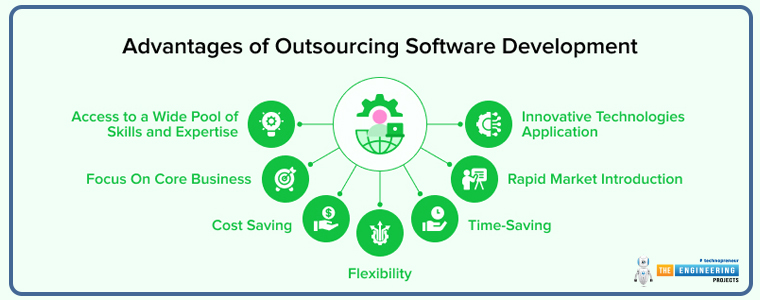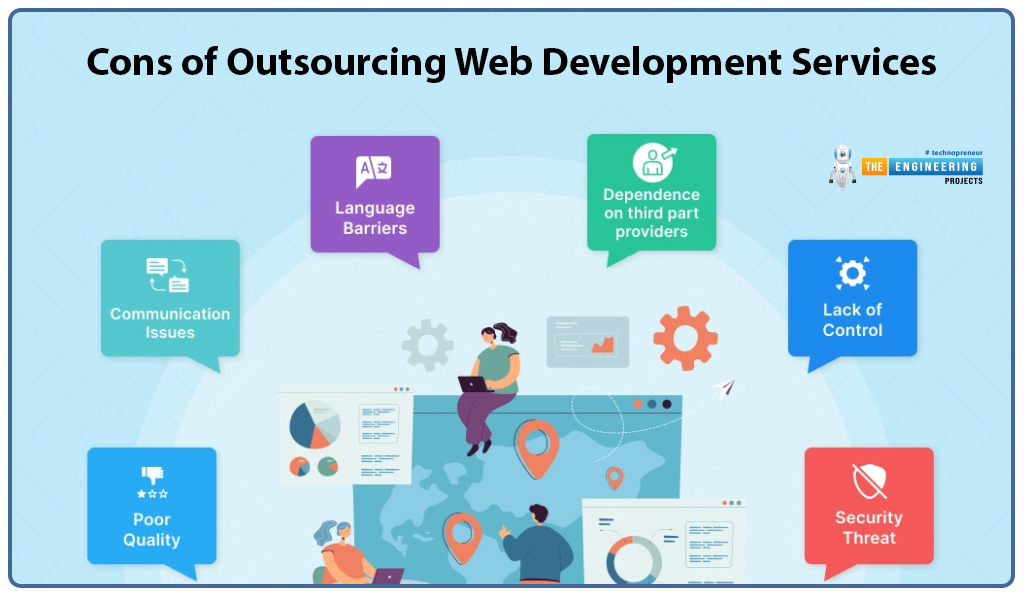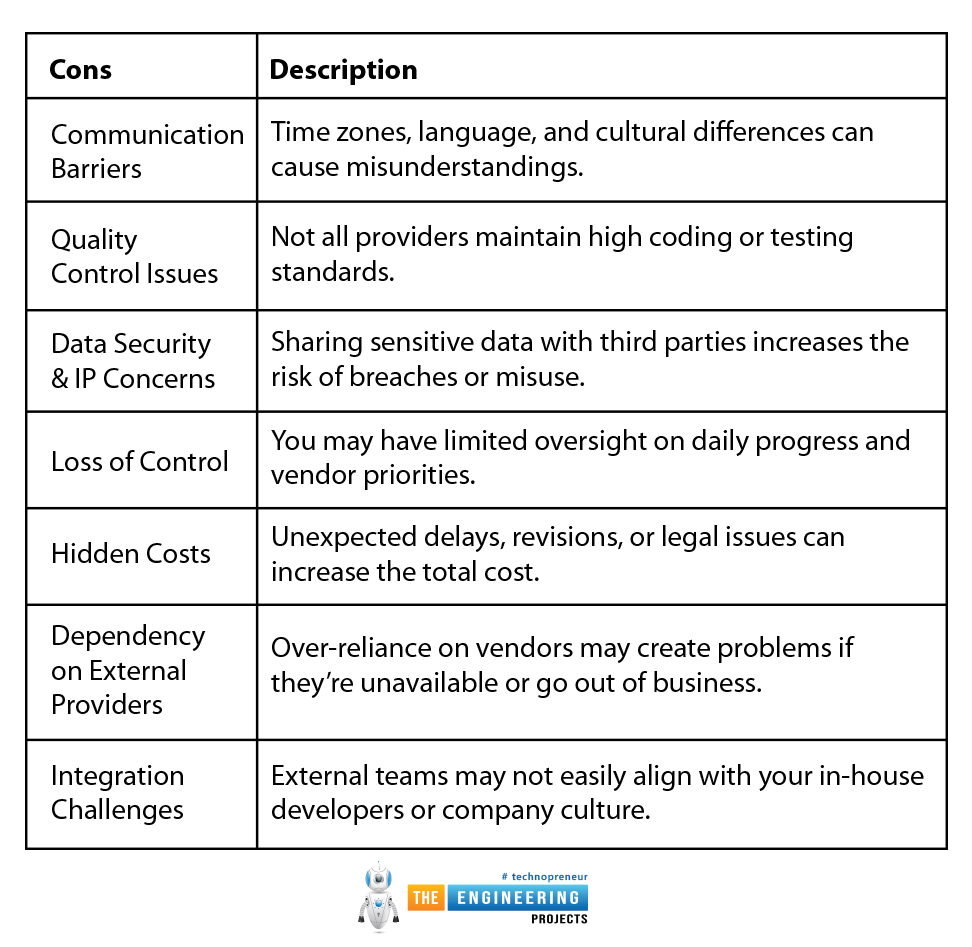
Hi readers! Hope you are having a great day and want to learn something new. Today, the topic of discourse is the pros and cons of outsourcing web development services.
Why construct the entire house when one can call experts to lay bricks cheaper and quicker? That's the philosophy behind the world trend of outsourcing web development services. In today's digital economy, many companies scramble to build a strong digital presence. Not every company can hire full-time developers or maintain high-quality websites actively. By outsourcing, companies can access global talent, save on development costs, and accelerate the timetable for getting to market with their projects.
It's not an easy task to outsource web development service but it allows companies to hire outside developers and get them to build their companies' websites or bring in coders periodically to improve their sites and add new features. This relationship can add new technology or specialized skills without taking on the costs of having a full-time employee. Outsourcing can help leverage scale or flexibility while allowing a company to focus on its key objectives. On the other hand, outsourcing has risks and challenges. Quality differences in personnel, poor communication, inconsistent delivery of objectives, data security issues, and hidden costs can all shift a potentially successful venture to being a costly mistake.

Here you will find outsourcing in web development, its pros and cons. Let’s dive.
What is Outsourcing in Web Development?
Outsourcing is where web-related tasks or work are performed externally via a service provider and not done in-house. The service provider can be a freelance web developer, a web development agency, or an offshore team in a different country. Companies will commonly outsource front-end and back-end web development and UI/UX web design, website performance testing, SEO, and any ongoing maintenance or updates, so you should understand the difference between web design and web development.

Outsourcing aims to access external development expertise, save time, save money, and access technology without creating a full in-house team. It has become a popular alternative for startups, small businesses, or perhaps organizations that need to grow digitally at a rapid pace. The world of online platforms and developing professionally available talent is global, and you can use outsourcing as a strategy for website development and still concentrate on developing your core business.
Pros of Outsourcing Web Development Services:
More companies are now deciding to outsource their web development services. Not only do they want high-quality websites, but they also want to build those sites without the challenges and costs of hiring a full-time development team. Businesses of every shape and form, from startups to major corporations, uncover the benefits of outsourcing their development needs to a third party. Listed below are the main advantages of outsourcing web development needs:

Pros |
Description |
Cost Efficiency |
Save money on salaries, infrastructure, and overhead by hiring affordable global developers. |
Access to Global Talent |
Work with skilled experts from around the world, including niche specialists. |
Faster Project Completion |
Experienced teams and parallel workflows can speed up delivery times. |
Focus on Core Business |
Free up internal resources to concentrate on sales, marketing, and growth. |
Scalability & Flexibility |
Easily scale your team up or down based on project needs. |
Latest Tools & Technologies |
Gain access to modern tools, platforms, and expertise without buying expensive software. |
Risk Mitigation |
Established agencies often offer NDAs, maintenance, and structured project management. |
1. Cost Savings:
Cost savings is arguably the best reason to outsource your web development needs. Creating a full-time internal development team incurs a large amount of costs: salaries, benefits, hardware, software licenses, office space, training, etc. Outsourcing will eliminate the majority of the overhead involved.
Lower labour costs: there are developers located in India, Eastern Europe (i.e., Ukraine, Poland), and South East Asia (i.e., the Philippines, Vietnam), with amazing skills, who can build high-quality sites for often substantially lower costs than their counterparts in North America or Western Europe.
No hiring or overhead: If you outsource the development work, you no longer have to spend time and money hiring and onboarding, and making the physical space a work environment for the development team.
Budgeting: There are tons of outsourcing firms that will market themselves to companies like yours, and their project pricing model can differ widely. Some work hourly, others do project-based pricing. Knowing you can cost manage better is often much better for business.
2. Access to a Global Talent Pool:
With outsourcing, your potential talent pool is not limited to your local market; instead, you have access to a global pool of potential talent and specialists who bring different experiences and domain-specific knowledge.

Need a React developer with prior experience in healthcare applications?
Want a UI/UX designer who follows WCAG guidelines for accessibility?
Need back-end specialists with experience in AWS, Node.js, or Django?
No matter the niche, outsourcing allows for access to expertise in a specific domain that may be difficult or expensive to find locally.
3. Quicker Project Delivery:
Outsourcing teams and development agencies are usually set up to complete projects faster because of their expertise, efficient workflows, and access to committed resources.
Several developers can develop multiple modules concurrently.
Most agencies adopt agile development methodologies, accelerating time-to-market.
Simplified development cycles enable companies to react fast in response to market needs or competition.
4. Focus on Core Activities:
Outsourcing technical activities allows your internal team to focus on their core strategic functions, with tasks like business development, customer service, or marketing.
Without wasting time and resources on low-value tasks.
Keep your productivity and effectiveness in your core departments while the outsourced team focuses on the web work.
That division of efforts enables organizations to stay focused on the big picture and improve overall effectiveness.
5. Scalability and Flexibility:
Outsourcing offers a flexible platform to scale your development team up or down depending on your project requirements.
Rolling out a big feature? Temporarily hire extra developers.
Completed the project? Scale down to maintenance support only.
This is difficult to do with an in-house, full-time team and enables companies to stay lean and agile.
6. New Tools and Technologies:
They spend a lot on contemporary tools, platforms, and technologies. With them, you indirectly avail yourself of these innovative resources without having to pay for costly licenses or training.
7. Risk Mitigation:
Established web development companies usually have strict project management guidelines, such as timelines, budgets, and milestones, lowering the chances of failure.
Some also offer:
Non-disclosure agreements (NDAs) are used to guard intellectual property.
Warranties or post-launch maintenance periods to deal with bugs or problems.
Disadvantages of Outsourcing Web Development Services
Though with numerous advantages, outsourcing also has serious challenges and areas of potential risk that need to be managed cautiously.
Cons of Outsourcing Web Development Services:

Though outsourcing web development services can have benefits such as cost savings, access to a global talent pool, and scalability, it does, nevertheless, expose businesses to several disadvantages and risks that need to be managed. If managed poorly, these drawbacks may lead to project delays, lost money, or lost product quality. Here is a closer look at the most significant challenges of outsourcing web development services:


Cons |
Description |
Communication Barriers |
Time zones, language, and cultural differences can cause misunderstandings. |
Quality Control Issues |
Not all providers maintain high coding or testing standards. |
Data Security & IP Concerns |
Sharing sensitive data with third parties increases the risk of breaches or misuse. |
Loss of Control |
You may have limited oversight on daily progress and vendor priorities. |
Hidden Costs |
Unexpected delays, revisions, or legal issues can increase the total cost. |
Dependency on External Providers |
Over-reliance on vendors may create problems if they’re unavailable or go out of business. |
Integration Challenges |
External teams may not easily align with your in-house developers or company culture. |
1. Communication issues:
Communication is vital to any successful web development project. Certainly, when outsourcing work, and especially with teams located in other countries/time zones, communication can be hindered in multiple ways.
First, there may be delays in response to meeting times and scheduled appointments.
Second, language variations may lead to misunderstandings in order details, timelines, or even design expectations.
Finally, cultural behaviours may relate to working processes and attitudes towards deadlines and urgency.
The distance between teams can lead to frustration, misaligned expectations, and costs in some instances. Check-in meetings, collaboration tools, and clarifying communication protocols are an important strategy to limit these impacts.
2. Quality Control Issues:
Not all outsourcing partners produce services with the same level of quality. If you choose the wrong vendor, this could lead to:
Poor coding practices can lead to future complications in updates and maintenance.
Confusion from a lack of documentation when the project changes hands.
Insufficient testing will most likely introduce bugs and provide a poor user experience.
Without adequate oversight and quality assurance, you could end up with a product that neither meets your expectations nor those of the end-user. Hence, doing sufficient due diligence and running a few pilots to assess any vendor's capabilities before you dive into a full relationship is useful.
3. Data Security and IP:
Sharing sensitive business information when engaging with third-party vendors, especially with overseas vendors, also creates concerns over data security and intellectual property:

Potential for a data breach if the vendor does not have appropriate cybersecurity mechanisms in place
Potential for your proprietary code or designs to be stolen or used without authorization
The degree to which the NDA or legal protections will be enforced, given each jurisdiction's unique practices of enforcement
For these reasons, it is critical to have strong contracts, stipulate the data protections that they must adhere to, and ensure that the vendor adheres to international standards such as GDPR or ISO/IEC 27001.
4. Loss of Control:
Outsourcing offers an avenue to your critical development with an external team, which can often have visibility and control issues.
You may not always have insight into whether or not your vendor can deliver on time.
Making scope changes during the project can be time or costly.
The vendor may prioritize your project the same as other clients.
5. The Disguised Costs:
Outsourcing is often touted as a way to save money, but it can also lead to unexpected costs, including:
Delayed timelines that increase total costs.
Rework resulting from poor quality or assumptions not aligning.
Contract renegotiations or legal disputes.
Organizations need to plan resources for contingencies, if those surprises lead to either greater costs or reduced capacity.
6. A Dependence on an Outsider:
Outsourcing typically leads to a long-term dependence on a third-party vendor. This dependence can become a burden if:
The company providing support goes out of business.
The key team members leave the company or are re-allocated.
The response timeline does not align with your business needs.
Being dependent on an outside vendor can be especially problematic in urgent situations, and especially for technical support. The best way to minimize both tendencies to dependence is to have multiple vendors or keep some part of the development in-house.
7. Challenges with Integration with Your Existing In-House Team:
If your company already has an internal development team, integrating external support can present challenges of collaboration and culture:

Different coding standards and documentation styles can present challenges to consistency.
Internal team members may resist and have conflict with the external outsourced team about decision-making.
Concern about resentment and distrust from internal contributors in the project is a risk.
You can successfully integrate external contributors by establishing relatively clear communication lines and decision-making authority, along with shared project management tools, and having a single development workflow.
Conclusion:
Companies find outsourcing quite beneficial - when outsourcing, it allows companies to reduce costs, be more efficient because of shorter turnaround times, and leverage expertise from around the globe. Outsourcing tends to be rather appealing to small firms and possibly even start-ups that do not have the resources to hire a full-stack team. It allows small firms to have websites built, roll out new features, and ultimately be competitive without the headache of sourcing, managing, and holding full-time members in every single one of those interactions.
Of course, there are downsides to outsourcing. One negative is if there are communication issues, especially if it is a team in another country, for example, language and/or cultural content. Also, the quality could simply not fit your expectations - you may not know this till the end. There is also some risk taking when disclosing your business-critical information to teams that may not only be outside your organization but could also be in another country. This raises challenges: you must select the right partner, create clear specifications to communicate your needs to the vendor, and remain as involved as you can in the development process.



